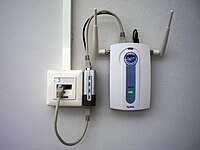
Photo from wikipedia
In massive multiple-input multiple-output (MIMO) systems employing hybrid analog-digital precoder, there are two commonly used antenna structures that have their own pros and cons, namely, the fully-connected antenna structure (FCAS)… Click to show full abstract
In massive multiple-input multiple-output (MIMO) systems employing hybrid analog-digital precoder, there are two commonly used antenna structures that have their own pros and cons, namely, the fully-connected antenna structure (FCAS) and the partially-connected antenna structure (PCAS). The FCAS achieves better spectrum efficiency (SE) even with reduced radio frequency (RF) chains, but the hardware cost and power consumption are still grievous. Contrarily, the PCAS has less hardware cost and power consumption, but suffers from severe performance loss. In this paper, by combining the advantages of both structures, we first propose a sparse adaptive antenna structure (SAAS) for the implementation of the hybrid precoder, which can jointly control the on/off state of all phase shifters (PS) and RF chains through a switch network. Then, a sparse hybrid precoding (SHP) optimization problem based on the proposed SAAS is established aiming at minimizing the total power consumption under individual average data rate requirements. To tackle the challenging non-smooth non-convex stochastic optimization (NSO) emerged with the SHP design and reduce the power consumption of PSs and RF chains, we propose a sparse smooth approximation based an online algorithm to find a stationary point of the NSO problem and establish its convergence. Simulations verify that the proposed antenna structure and algorithm achieve a better balance between power consumption and system throughput than the existing schemes.
Journal Title: IEEE Transactions on Wireless Communications
Year Published: 2022
Link to full text (if available)
Share on Social Media: Sign Up to like & get
recommendations!